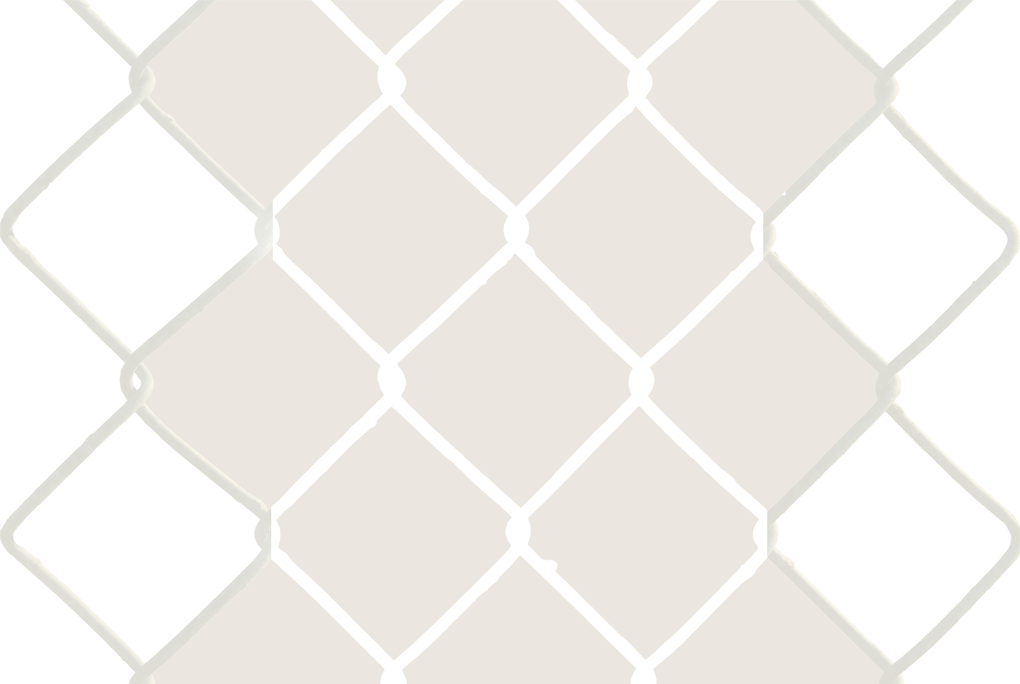During a panel discussion in 2010, Detroit-based documentary photographer Carlos Diaz philosophized, “How do we perceive…reality?” And, as an artist who expresses a politicized view of the real utilizing the format of the photo-essay to this end, he added: “How do we [re]present our reality?”1 Artistic investigations into the nature of human perception have shaped the period of the modern since the beginnings of French Realist painting in the 1840s–what Roland Barthes calls photography’s “reality effect” can also be applied to painting2—but confront long-standing philosophical inquiries into the veracity of the faculty of seeing as a gateway onto knowing. Art and photography critics in the early decades of the twentieth century complicated a simple notion of photography as merely a veristic document, but how seeing constructs subjective visions of the real has been acknowledged since the Enlightenment. Such a philosophical line of thought reconfigures modern photography (as an extended or augmented expression of the faculty of seeing) to be an investigative tool into the constructedness of human experience and cognition.
Contrary to commonly held assumptions promoted by early modern photography critics, which held photography to be a verifiable document with a claim to objective truth, the camera eye—as an extension of the human eye—is inherently subjective. Henceforth, ontological discussions of modernist photography since the 1910s and 1920s embedded in legacies of the Bauhaus have become inseparable from discussions of photography as a fine art, here meaning the aesthetic pursuit and intensified effects of light, line, space, shape, grain, cropping etc. through the artful employment of photographic technology, and a range of formal and aesthetic choices. Photography, then, is inevitably both subjective and objective. It records and reconstructs the concreteness of life: the world and the position of the photographer within it. Initiating waves of postmodern and poststructuralist deconstructions of experience as inevitably subjective in the 1970s, Barthes coined the now familiar term of “the reality effect” in 1968 in reference to the dual nature of the medium as document and contrived artistic utterance.3
Diaz’s photographic practice, which spans the early 1980s to the present day, utilizes the comparative power latent in the sequentiality of the photo-series—rather than the single photograph as a standalone image. Reading the image as if it were a “text” enhances photography’s political potential by foregrounding authorial intentionality more firmly. More specifically, the photo-essay, often presented in book form accompanied by text, has been part of a paradigmatically modern legacy of documentary photography that considers photography to be an epistemic device to unravel aspects of reality conventionally not seen or overlooked. This reflection raises the question of the politics of photography. On the one hand, political ideology frequently derives from the agenda of the photographer-as-artist. As American photography critic Alan Trachtenberg states so poignantly in his discussion of American labor photographer Lewis Hine, whose work compares to Diaz’s, “he and not his camera was in control...he showed what he felt and thought about the reality that he put under the looking glass of photography.”4 On the other hand, all art (including photography) is experienced and processed by an individual viewer and meaning is situated beyond the single intentionality of the author in that which is culturally shared. French art historian Hubert Damisch demands an active onlooker, qualifying that the receptive viewer must execute an interpretive act: “[a photograph] reflects phenomenologically—in the strict sense of an eidetic experience, a reading of essences—on a cultural object, on an essence that is historically constituted.”5 The connective logic of the photographic series and the arousal of an analytical viewer are the precondition for the political quality of photography.
More to the point, Diaz is a socially conscientious documentarian concerned with issues of labor and the human condition; he employs the photo-essay to explore and critique the everyday dynamic of early modern, capitalist society as it persists today in a postindustrial society of the digital in an age of information and service. Perhaps unsurprisingly, given the culturally contingent nature of photography, modernity has been a key subject in photography since its very inception; Paris, a city in which forces of labor and leisure are deeply engrained in the city’s social and physical landscape, gave birth to photography in the 1830s. The urban centers of Detroit, Las Vegas and New York, together with their surrounding leisure outskirts, captivate Diaz in his quest for a photographic archeology. American labor relations, economic struggle and the role of the immigrant worker in the city are foregrounded in photographs of Coney Island in Brooklyn, the Wade/Pugh carnival in Ann Arbor or life in the streets of Las Vegas. As a second generation American, Diaz’s cultural heritage influences his aesthetic and intellectual choices as he lays bare a social body that he is both familiar and unfamiliar with; his Mexican grandparents (with roots that reach back as far as Aztec culture) came to Saginaw, Michigan, to work in the sugar beet industry. As modern photographers since the early twentieth century have become prone to do, his work also thematizes how photography itself represents an act of craft-based labor on the margins of art. Art is a form of commodity embedded in acts of consumerism. This text presents some preliminary thoughts on Diaz’s politics of labor by looking at it through the lens of cultural critic Guy Debord whose ideas on labor and society seem to resonate well with Diaz’s artistic project overall. A photo-series from 1981-1983, the Wade Entertainment Shows in Ann Arbor, together with a series on Las Vegas from 2008, and the “Invented Landscapes of Coney Island” from the same year, address concerns with labor, art and the machine by shifting the terms of the discussion ever so slightly. Collectively, they re-frame the familiar as unfamiliar, creating a dialectic between what is recognizable and what is unnoticed. His work also addresses how the emergence of capitalist theory in the late eighteenth century exposed leisure as the “other” side of labor; a cultural shift that was brought into being and was regulated by the introduction of factory hours during the industrial revolution. Diaz recognizes the pivotal role photography has played in enforcing and propagating colonialist imperialism used to discipline non-Western cultures.6 And, finally, Diaz reflexively demonstrates how photography itself is an act of craft-based labor.
Carnival Ride Attendants: Wade Entertainment Shows, 1981-1983
In his choice of locations and themes, much of Diaz’s work hearkens back to the industrialization boom years of Paris in the nineteenth and early twentieth century; Diaz (not unlike a modern painter) examines the circus, the carnival, vaudeville entertainment, the World’s Fair (and its later American manifestations), the vernacular amusement landscapes of Las Vegas and Coney Island, and—in the case of the “Carnival Ride Attendants”—Ann-Arbor’s Wade/Pugh Entertainment Shows. In this way, Diaz avoids high art, bourgeois forms of entertainment (as the opera or the ballet were often considered) but highlights working-class manifestations of leisure culture. In the manner of an urban flañeur and scavenger, a preoccupation with these working-class forms of leisure was kindled by a love for old and new books; during his many excursions to John K. King Used and Rare Books in Detroit, Diaz encountered a wide selection of nineteenth century vintage publications and postcards (some of which thematized the carnival and circus as an early form of modern entertainment) that would become formative influences. In 1981, for his first major series of photographs (a few years prior to graduating with an M.F.A. in photography from the University of Michigan School of Art in 1984) Diaz followed carnival workers in Ann Arbor over three consecutive summers, shooting black and white images with a film medium-format Hasselblad camera in a square format.7
Wade Shows Inc. was founded by Lee Wade in 1912 as a family-run business. As the company’s ostentatious website self-assuredly declares: “Wade Shows is North America’s premier carnival company. Our unique spectacular rides and attractions, unparalleled customer amenities and service-oriented staff are the reasons we set the standard in the industry.” Furthermore, Wade Shows Inc. boosts affordable, family entertainment and ecological conscientiousness as the “greenest carnival on the road.” Here, we find a specifically modern discordance between the corporate mechanics of a superstructure and the everyday reality of what Karl Marx called “the labor base” in his programmatic publication of the Capital in 1867 (Verlag von Otto Meisner). The carnival workers’ daily experience appears starkly separated (if not altogether excluded) from the site’s glossy promotional appearance. One can readily see that—wherever bureaucratic capitalism has planned and built an environment—the conditioning of the worker has been perfected, and the rights and liberties of the individual laborer have been limited in order to prevent an infringement on the self-styled, public appearance, considered a curtail of revenue. Wade Shows Inc. was bought in the 1970s by Frank Zaitshik who transformed the local business into a national venture with headquarters in Michigan and Florida—all while preserving its online front as a familial enterprise catering to the working classes. This transformation reflects a Marxist-oriented view of society that insists on a structural dialectic between deceptive surface and the “real” that lies behind it. Exposing and exploring this dialectic remains one of Diaz’s major intellectual concerns as an artist. Diaz re-presents reality in order to make visible through framing, cropping, printing, and assembling–in short, all the formal and technical devices of the medium available to the artist–what is otherwise not readily seen: namely, the conditions of the working class that underwrite consumerist reality from the beginnings of the industrial revolution to the contemporary moment. Diaz reminds us that “the life of a ‘carnie’ is far from glamorous, the job is in fact dirty, demanding and dangerous.”8 Legacies of commodity criticism are as old as the medium of photography itself: they rose to the forefront as a form of cultural critique when the French government accepted Luis Jacque Mandé Daguerre’s patent for the Daguerrotype process and photography was officially announced as a new scientific invention in 1839 in Paris. As a result, a predominantly image-driven culture (later to be termed a “culture of the spectacle”) followed on its heels, complementing a text-based society propelled by the invention of the printing press.
This media-driven culture reached new heights during the postwar 1950s when consumerist affluence shaped by the American economy’s new stronghold on war-torn Europe. In the Ann Arbor Carnival series, Diaz seems to take the position of French critic Guy Debord, who assesses in the Society of the Spectacle (Buchet-Chastel, 1967) the devastating and inescapable consequences of consumerist culture on all aspects of everyday life. In an extension of Karl Marx, Debord makes very clear that “the liberation from work,” what we call leisure time, is “neither a liberation within labor itself nor from the world labor has brought into being.”9 In this programmatic text on the exploitation of the worker by the bourgeois factory owner, he ascertains the crucial role that the mass media play as an instrument of manipulation that reinforces the reigning class distinctions in a society driven by a false reality created by imagistic media representations. Debord links leisure time to the humanity of the worker as he asserts a “total contempt” for the worker, who is duped into believing by the capitalist ruling class that “once work is over, [we are] treated like grown ups.”10 According to Debord, this belief—that the worker’s self-fulfillment and the gratification of his desires are made possible by the pursuit of leisure—is only a ploy to enhance his role as a consumer.11 How, then, can photography as an image-based medium promote the humanity of the laborer and unmask what Debord calls the “false consciousness of the worker”? To put it another way, “the spectacle is not [just] a collection of images; rather, it is a set of social relationships between people that is mediated by images.”12 The issue of photography’s role in a society of the spectacle contains an ethical component. Debord believes that modern, image-driven media utilize the common photograph to manipulate and blind its viewer with the apparent veracity of the document to the dynamics of consumerism: a single snapshot of reality blocks out the larger connective tissue of society as a whole and it has the ability to promote the interests of capital by serving as an advertisement for a certain lifestyle. An artistic image, thus, ought to reveal how reality, as a human activity, is a social and cultural construct. As Susan Sontag points out in On Photography, published in 1977 (Farrar, Straus and Giroux), moral issues are political issues implanted into photography by the artist and the seeing viewer: “What determines the possibility of being affected morally by photographs is the existence of a relevant political consciousness.”13 When viewed through this lens, Diaz’s photographic work appears inherently political. His practice seeks to restore the worker’s humanity as a moral issue by rekindling public awareness that the world today (as the world of the nineteenth century had been) remains built on immigrant and working class labor too often unacknowledged and rendered invisible.
In the “Carnival Ride Attendants,” Diaz places his subject–a single worker–in the middle of the frame; the subject faces us, the viewer, head-on from the central axis of the picture. This composition evokes a millennia-long tradition of Greek Classicism and its extension in Renaissance art where the geometric space of the rectangular image field organizes around a single focal point that lies near the center at eye-level. In this pictorial tradition, the story’s protagonist directly faces the audience in order to establish eye contact with the viewer and create a sense of pathos between subject and onlooker.
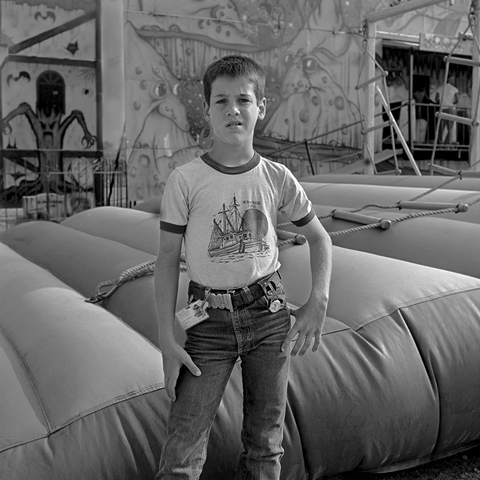 |
| Carlos Diaz, “Carnival Ride Attendants: Joey, Wade Entertainment Shows,” 1981-1983. |
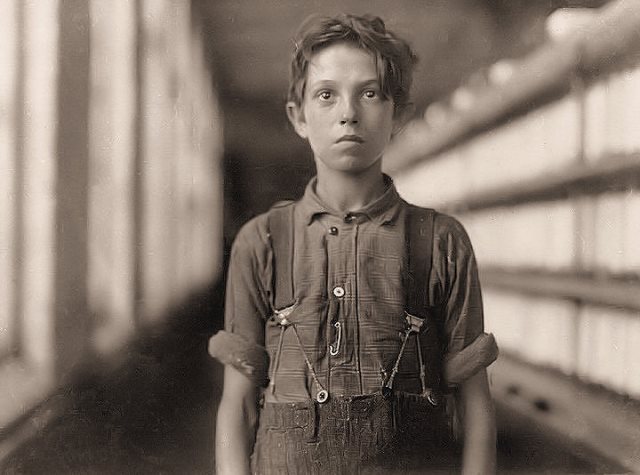 |
| Lewis Hine, “The Mill: Jo Bodeon, a back-roper in the mule room at Chace Cotton Mill. Burlington, Vermont,” May 1909, The U.S. National Archives, Washington D.C. |
Diaz extends a modern legacy of the social document and its emphasis on humanity’s disenfranchised by utilizing conventions of fine arts portraiture; this staged aspect of a straight documentary aesthetic often goes unacknowledged but it was already present in the legacy of social documentary that emerged most forcefully during the Great American Depression in the early-to mid 1930s: the Farm Security Administration (a New Deal government agency sponsoring relief efforts to alleviate the plight of migrant laborers between 1934 and 1944) famously commissioned Walker Evans and Dorothea Lange to capture the humanity and perseverance of the worker in photo-essays that both inform the public of plight and justify their cause securing more funding. Following this compositional tradition, Diaz instructs his subject(s) to look directly into the camera. By extension, the photograph invites the viewer to embody the experience of the cameraman himself in an act of projection, therefore moving closer to the image’s chosen subject. Lewis Hine, an American sociologist famous for his deliberatively scientific approach to photography, develops the pictorial model of “the human document” adopted by Evans and Lange two decades later: a head-on mode of address in which a centrally positioned subject makes eye contact with the camera. Hine’s labor images of underage children in American cotton mills between 1908 and 1912 illustrate this stark, even political aesthetic very clearly; child labor was restricted but not yet banned by Federal law as late as 1938 and he sought to direct attention to the issue through his photographs. Hine also employs a dramatic spatial vortex that, although perspectival, exaggerates orthogonal thrusting in combination with a softened or indistinct backdrop. Resultantly, orthogonal lines and lines with right angles meet in a focal point outside of the photographic space. In effect, the figure is pushed toward the foreground, cut below the waist to bring the sitter nearer to the viewer. As Hine’s pictorial legacy reveals, the two poles of straight photography (as an objective document) versus the expressivity of fine arts photography (as a subjective and emotionally enhanced reproduction) must be taken with a grain of salt. Rather than assume an absolute position of opposition, these two poles are better considered as differentials to varying degrees.
Unlike Hine, Diaz integrates both foreground and background into a continuous depth-of-field, thereby lessening any blurring of contrast in the image, nor does he employ a pictorial exaggeration of dark and light for enhanced emotive drama. A different type of formal tension emerges: the paradigm of mono-focal space is rejected and, instead, a pattern of oblique lines at random angles that crisscross and intertwine figure and background is set in play, dynamically leading the viewer beyond the confines of the frame. Importantly, the sitter in Diaz’s work poses more naturally (rather than standing stiffly and somewhat forcibly) in a relaxed–if not altogether self-chosen–pose, thereby revealing performative aspects of character and identity. One can see in the photograph below the confident self-assuredness of Diaz’s subject; further investigation reveals this boy to be the son and heir of the Wade carnival owner. Diaz’s work articulates the intangibles of his subject’s character and personality. In this regard, another comparison warrants brief attention here.
Diaz’s pictorial choice for a squared frame may be viewed as overt homage to Diane Arbus and her portrait series highlighting marginalized communities, individuals and alternative social spaces. Diaz became aware of her work in college when a retrospective and monograph of her work traveled to the Detroit Institute of Arts and throughout the United States in the early to mid-1970s, after her suicide.
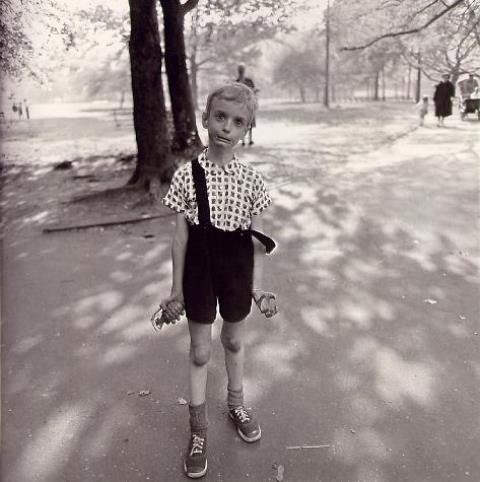 |
| Diane Arbus, “Child with Toy Hand Grenade in Central Park,” New York, 1962 © Diane Arbus. Diane Arbus Estate. |
 |
| Carlos Diaz, “Carnival Ride Attendants: Joey, Wade Entertainment Shows”, 1981-1983. |
Arbus characteristically shot in black and white with a twin-lens reflex Rolleiflex camera in her signature-style 2.25 inch square format, focusing on dwarves, giants, freaks, mutants, acrobats or transgender individuals whose physical features or behaviors have been historically perceived as ugly, repulsive or offensive. One can see in Diaz’s work a formal as well as thematic kinship to Arbus’s sensibility, which demonstrates an affection for American entertainment culture and the overlooked individuals employed by it by humanizing the marginalized and providing a platform for their self-exhibition.
As we ought to consider the overall logic of the Carnival Attendants series and not just address the compositional logic of the single image, this photo-essay uniquely juxtaposes images of portraiture against imagery uncannily void of human presence altogether. Throughout the essay, non-human paraphernalia—plastic-wrapped caps, garbage cans, open moving boxes, the empty back of a truck, or fences lying broken down on the ground—intrude on the sequence, where they appear either as background detail or pictorial subjects onto themselves.
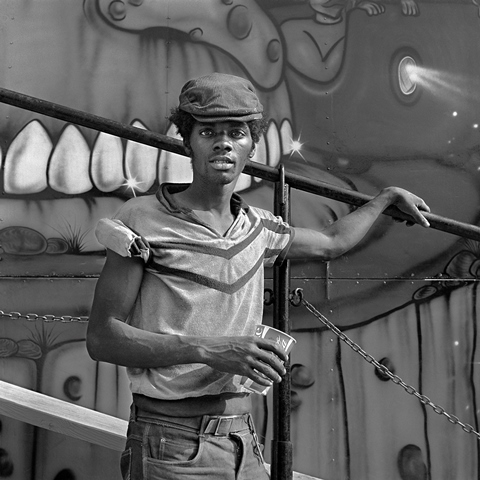 |
| Carlos Diaz, “Carnival Ride Attendants: Wade Entertainment Shows,” 1981-1983. |
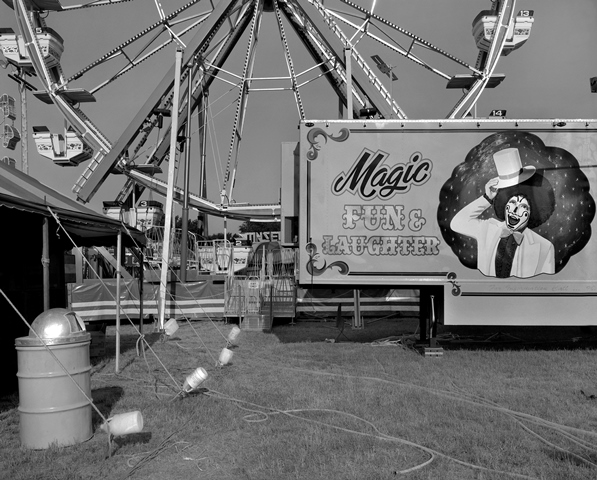 |
| Carlos Diaz, “Carnival Ride Attendants: Wade Entertainment Shows,” 1981-1983. |
Every second image in the sequence omits human presence entirely (no workers). Furthermore, the series as a whole intentionally excludes consumers altogether, placing its pictorial focus exclusively on laborers. By dint of these absences, Diaz draws our attention to our uncritical consumption of entertainment and the frequently overlooked effort that goes into creating amusement structures: the repetitive tasks of stacking, wrapping, carrying, loading and building remain unacknowledged when having “fun.” Uncannily, in Diaz’s landscape-based photography, the centralized axis falls along a beam of steel, the sidelines of truck (with the inscription “Magic. Fun & Laughter, for example), a supportive iron rod or a metal staircase; this invokes themes of automation and the redundancy of craft-based labor—both issues of real concern to the worker. These “human documents”—Hine’s term also hints at the unification of distinctive genres of social documentary and portraiture—confront the viewer with an interesting dialectic: Diaz’s photography, just like Hine’s, present the worker as both an individual and as a type, allowing for the social message to be simultaneously specific (the conditions of labor in cotton mills and Wade’s amusement parks) and general (leisure culture at large). In his desire to portray the spirit and resilience of the worker, Diaz extends Hine’s legacy of labor photography. It is in this light that Hine’s words—“my intent, in making the photographs, was to represent the humanity of these individuals”14—can speak for Diaz’s projects. Paradoxically, it is the very absence of the worker in Diaz’s photography that makes the strongest case for the worker. The machine, for Hine and Diaz, is not seen in opposition to the laborer but as a tool and product of his craft. As Hine prophetically notes, “cities do not build themselves, machines cannot make machines… both of them are the brains and toil of men.”15
Just as the concept of the human document was an extension and a renewal of Hine’s legacy, Diaz—who trained at the College of Creative Studies under the auspices of seminal Detroit-based street photographer Bill Rauhauser—shares commonalities with the way in which Rauhauser conceptualizes picture space as dynamic and diagrammatic in the manner of an engineer.16 Interestingly, both photographers’ compositional skills are distinguished by their experiences with machines; Rauhauser worked as a mechanical engineer; Diaz was employed as a draftsman at General Motors and mechanical designer at KMS Fusion during graduate school—this partially explains their shared penchant for strong linearity and the graphic quality of photographic composition.
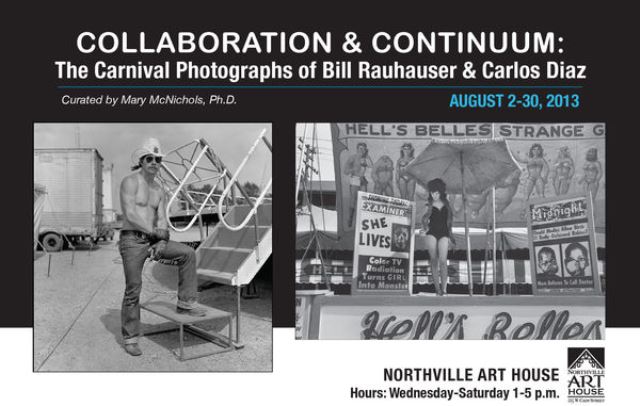 |
| Title page of exhibition catalogue Collaboration & Continuum: The Carnival Photographs of Bill Rauhauser & Carlos Diaz, Northville Art House, 2013. |
Despite some pictorial similarities, Diaz and Rauhauser differ in technical aspects, choices of format, composition, and thematic focus. Most notably, Rauhauser works with a 35mm rangefinder camera and crops his image space such that the photograph’s rectangular format echoes graphic lines within the picture space with a special attention to the upper and lower lateral lines; vernacular writing on signs and windows reinforces this formal emphasis. Diaz, in contrast, uses medium format and 8x10 large format cameras to focus more exclusively on the worker as an individual rather than on contextual urbanity itself. His square-framed images highlight employer-employee relations in a more exclusive focus on humanity of the laborer and thematize one of modern art’s key preoccupations: the connection between man and machine.
For many radical artists of the historical avant-gardes in early twentieth century Europe—such as the Italian Futurists in the 1910s or the Russian Constructivists in the 1920s—the worker appears as a human machine: he is the source of energy that powers modernity. As a result, the worker (as single subject) harbors the potential for a progressive future driven by man and machine in symbiosis. Modern avant-garde art therefore imagines society to function as efficiently as a machine does. Diaz’s work touches on this key paradigm of modern culture, in which the machine and the body become not only intertwined but fully interchangeable, thereby setting him apart from fellow contemporaries like Rauhauser, whose work by-and-large does not demonstrate these thematic preoccupations. The very absence of the worker only makes his presence felt more intensely.
Labor—in Diaz’s work—appears intrinsically connected to its dialectical other: leisure as pleasure. Fundamentally speaking, amusement parks exist to satisfy human desire. The machine becomes a metaphor for the human body as the organ of desire. Extrapolating this concept even further, modernity itself—and human industrial progress, it could be argued—is fueled by desire.
Spectacle and the American Landscape: Las Vegas, the City, and the Strip, 2008
During his visit to the “city of sin,” Diaz photographed the Luxor Las Vegas, a hotel and casino fashioned after the Great Pyramid of Giza. Built between 1991 and 1993 in the heyday of postmodernist recycling of past architectural styles, it features over 4.000 rooms and is considered the ninth-largest hotel in the world; its sky beam projects bright light up into the dark night air. Looking at the gelatin silver print, shot using an 8 x 10 view finder camera, the viewer barely registers the presence of a tiny worker in the foreground who, clad in white overalls and carrying a white bucket of paint, coats the parking lot railing in white. This photograph unmasks the artificiality of Las Vegas as a pastiche of global cultural heritage sites, while simultaneously exalting the unsung heroism of the invisible figures who built the city’s structures: the workers and their hands. The monument in the background reminds us—ironically—that the worker has been excluded from such historical legacies since ancient times, and not just the present moment: all empires rest on the strength of men who died for it unrewarded and unnamed. The motif of the overlooked repairman reoccurs throughout the series; another example is the setting of the Venetian Casino where two men stand almost waist deep in the “lagoon,” repainting the area below the fence.
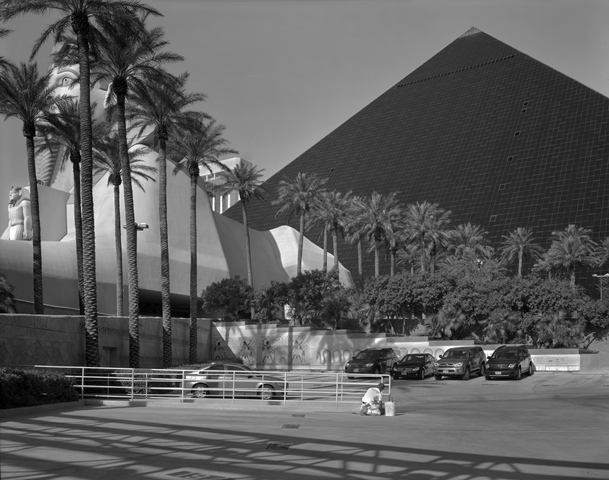 |
| Carlos Diaz, “Spectacle and the American Landscape: Las Vegas, the City and the Strip,” 2008. |
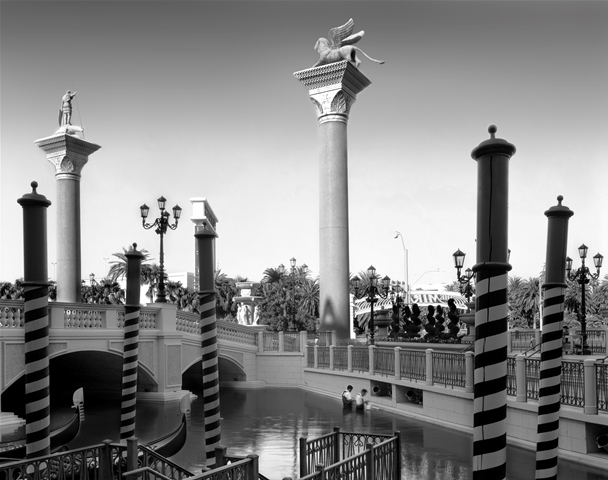 |
| Carlos Diaz, “Spectacle and the American Landscape: Las Vegas, the City and the Strip,” 2008. |
Hearkening back once more to Diaz’s affection for early modern influences, the artist—in a written statement that accompanies the series—compares Las Vegas to Coney Island; taking this comparison one step further, Diaz further links Las Vegas to the nineteenth century legacy of large-scale entertainment parks in Paris.17 Namely, the 1884 inauguration of World’s Fair culture that arose when, in the tradition of earlier trade shows, scientific and technological innovations were presented to vast audiences housed in buildings deliberately fashioned after worldwide, historical monuments. It’s most spectacular U.S. variant was the 1893 World’s Columbian Exposition in Chicago, IL, named to honor Christopher Columbus’s 400th anniversary of discovering the new world. Among its most famous attractions was the Court of Honor, nicknamed “The White City”: a series of buildings in neoclassical style with white stucco sidings and streets illuminated by electric lights. Searchlights cut the sky with wide swaths of electric light every night for nearly six months, further augmenting the stunning nature of the visual spectacle. Varyingly referred to by contemporary promotional campaigns as “a spectacle,” “magic,” or a “mystery,” this intensified stimulation of the senses (primarily through seeing) had a wide popular appeal, transforming the scientific novelty of electricity into a form of mass entertainment: science, for Debord, represents the foundation for a society of spectacle. Debord also asserts the primacy of seeing as the perceptual modality most suited to be co-opted by the spectacle.18 Crucially, the Situationist International of the 1960s—under the intellectual and artistic leadership of Debord—recognized that the spectacle (as commodity culture’s main mechanics of operation) perpetuates itself in part through manipulating the individual’s desire to experience pleasure. While Debord believed early on in his career that the individual can attain self-realization through creative expression, play and love—and can regain a lost, pre-industrial experience of unification—the spectacle, he later concluded, inevitably thwarts all genuine self-realization by re-routing the individual’s authentic desires towards commodified forms of leisure from which there appears no escape: here, pleasure, fantasy, and human imagination are also subject to the logic of the commodity.19 Debord also acknowledges, however, that art has the capacity to push against such relentless commodification and, ultimately, to stand in opposition to the dehumanizing effects of spectacle-based culture. This can be achieved by throwing a wedge into the functioning of the machine, by bringing the ever-grinding machinery to a halt, if albeit temporarily.
In Diaz’s Ann Arbor Carnival series, as in later bodies of work built on imagery shot in Las Vegas or at the Ford River Rouge Complex in Dearborn, machines appear in various states of disrepair or desolation—turned off, disassembled, unpacked—or outright obsolete. It is the very absence or standstill of apparent desire that provokes critical insight into the mechanics of consumerist pleasure—a viewpoint supported by Marxist thinking. The visual trope of the “defunct” machine features prominently in “The Invented Landscapes of Coney Island” from 2008. He recycles his own black and white imagery from his earlier Coney Island Landscape series from the 1990s. In addition to this act of self-appropriation, Diaz employs a modernist artistic strategy—first utilized by the Dadaists in the 1910s for political satire—as he cuts and pastes imagery from printed magazines and books on top of photographs to create absurdist machines that perform pseudo-scientific tasks. Reaching back into the history of art for artistic strategies is no isolated incident in his career. In “The Rouge: The Legacy of Detroit and the Autoworker” (2013-2014), the photographic lens isolates otherwise secondary aspects of labor such as a steel worker’s glove or a pile of coal, and enhances their inherent formal and pictorial nature by such means as close crop, zoom and color enhancement.
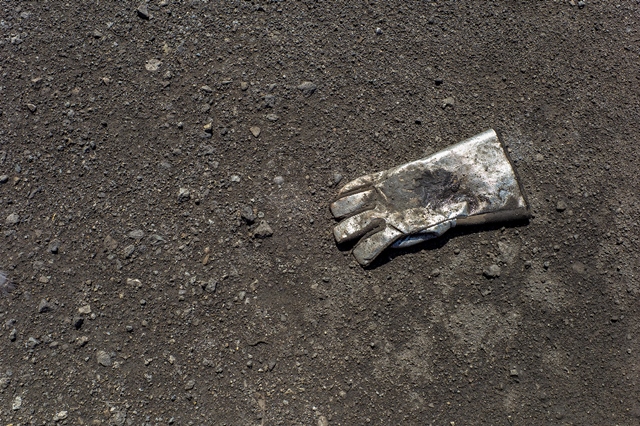 |
| Carlos Diaz, “The Rouge: The Legacy of Detroit and the Autoworker,” 2013-2014. |
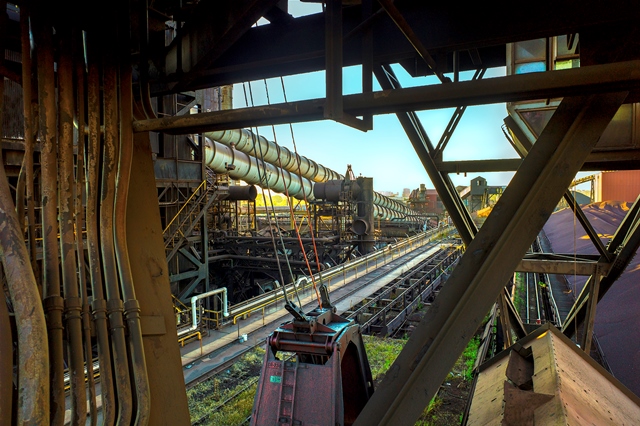 |
| Carlos Diaz, “The Rouge: The Legacy of Detroit and the Autoworker,” 2013-2014. |
These detailed images in the tradition of large-scale photography-as-painting are tableaux-like studies in texture and color. Here, grain, surface, light, line and shape are the emphasis in a replacement of mechanic functionality by isolating the otherwise overlooked aesthetic qualities of the machine, and the tools and supplies that are utilized in order to operate it, as fetishes of beauty that monumentalize labor and the machine. With the machine at a standstill, the site is visibly evacuated of human presence. Yet, the image is pregnant with presences: the absent worker, the machine as product of labor, the eye of the photographer. Walter Benjamin famously wrote in “The Work of Art in the Age of Mechanical Reproduction” in 1936,
By close-up of the things around us, by focusing on hidden details of familiar objects, by exploring commonplace milieus under the ingenious guidance of the camera, the film, on the on hand, extends our comprehension of the necessities which rule our lives; on the other hand, it manages to assure us of an immense and unexpected field of action.20
As he asserts, art can bring perception beyond the merely optical and realistic, and enable a tactile appropriation of life that penetrates beneath the surface of the visible—similar to the one Debord calls for.
If we seek to grasp the critical political potential of Diaz’s artistic employment of the modern machine trope as outdated, obsolete or simply dysfunctional in light of Debord’s ideas, we must return to “The Invented Landscapes of Coney Island.” Interestingly, in Debord’s reconfiguration of Marxist ideas, labor and leisure co-opt forces of desire and pleasure but fantasy and the imagination, when coupled with artisanal touch, can slow down the media machinery.
The Invented Landscapes of Coney Island, 2008
In the moody black and white gelatin silver prints from “The Invented Landscapes of Coney Island,” the photographer captures the amusement park as it is rarely seen: overcast, early in the morning and empty except for a few marginal subjects such as a single mother and an elderly gentleman. Just as Diaz photographs the Ann Arbor carnival ride attendants during the festival’s liminal moments—when the rides had just been built but were not yet functional—he captures Coney Island during the off-season (this time with a handheld 35mm Leica) while in New York on a field trip with students from the College of Creative Studies in Detroit during the late 1990s. This lends the imagery a forlorn and timeless feel. As mentioned earlier—and this is crucial here—vintage postcards, photographs and books shape Diaz’s vision of Coney Island, the circus and the freak sideshow as uncanny places that seem to sidestep time and history altogether as they are outdated nineteenth century forms of spectacular entertainment.21 Diaz utilizes the artisanal photo-collage format here—a medium explored by Dada and Surrealist artists such as Raoul Hausmann, Hannah Höch and Max Ernst in the 1910s and 1920s—for its satirical, political and self-referential potential. Printed imagery is cut and glued onto paper ground; a photo-collage, unlike a photo-montage, is always a unique hand-made original and, thus, renders the nature of the artistic process somewhat more transparent as the cut, rip or tear allude to the act of making.
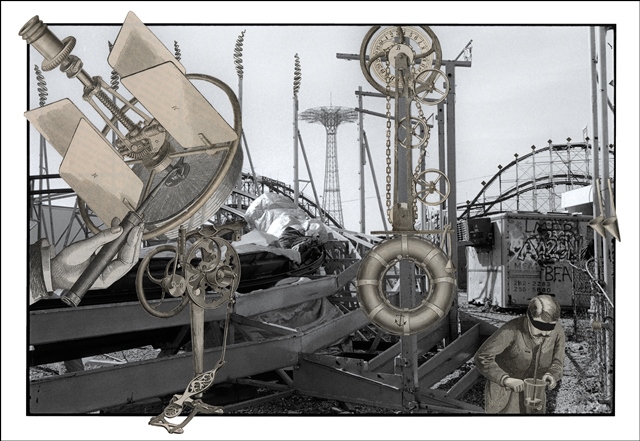 |
| Carlos Diaz, “The Invented Landscapes of Coney Island,” 2008. |
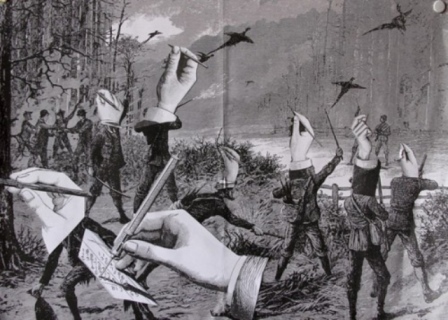 |
| Max Ernst, a single page from Une Semaine de Bonté: A Surrealistic Novel in Collage, Dover Publications, 1976. Originally published in 1934. |
Modern artists in this tradition assert and reveal that photography itself constitutes a form of labor; cutting, tearing and gluing are all processes visible to the attentive viewer who discerns a clash between image background and the strange figures inserted into the template. In “The Invented Landscapes of Coney Island,” each black and white print becomes a unique work of art overlaid with light-brown fragments culled from vintage, nineteenth century patent journals and Scientific American magazines. He intentionally sourced the material from a period of United States history between 1840 to 1890, when illustrations were hand drawn or carved onto steel plates or wood blocks, so as to capture the anachronistic spirit of the Coney Island ethos and return to the origins of spectacle culture.22 The graphic beauty of the print medium (steel plate and wood block engravings) further enhances a sense of obsolescence. The halftone or screen dot process came directly after and replaced the steel plate and wood block processes in the early 1890s because it was faster and therefore more inexpensive. Even further yet, this technology was replaced by an even more efficient means of mechanical reproduction: offset printing introduced lithographs to the U.S. market in 1903 when Ira Washington Rubel presented his new press to the public as more lasting means of mass distribution. This technology, in turn, would eradicate the artistic hand when photographic snapshots finally replaced lithographs.23 Obsolescence is the very way in which commodity culture keeps itself alive; a refusal to subscribe to the latest and newest can slow down the pace of capitalist consumerism. The dual celebration of the unique physicality and texture of craft-based imaging techniques such as wood cuts and lithographs, as well as an indulgence in the beauty of strange and fantastical scientific apparatii without obvious functional use, marks both Diaz’s and Ernst’s absurd and whimsical series as celebrations of the beauty and creative ingenuity of collage as manual labor. Capitalism and industrialization not only pushed artisanal labor to the sidelines but the media machinery of the spectacle further sidelined the material quality of the produced good, allowing promotion, advertisement, and the force of public opinion to decide over success or failure. Ernst invests the realm of nature (specifically, a bird hunt) with the libidinal energy of acts of writing that graft fantastical prehistoric birds onto the landscape, rendering it imaginary. Diaz turns toward the realm of industry and photography.
This emphasis on the hand and acts of making reminds us, once again, of Debord, who promotes art making as a form of manual labor in an industrial age. In particular, he argues that preindustrial craft can resurrect the importance of touch, a faculty of perception that stands in direct opposition to the dominance of the visualist image, which drives the media machinery of the spectacle.24 The immediacy of touch, unlike distanced and detached vision with its privileged access to the faculty of thought, which can be manipulated, can escape, it is believed, the spectacle due to its non-representational nature; the implicit agency of the tactile as a pattern of proximity threatens the detachment and passivity exerted by the spectacle from a distance that implies control. As Debord notes in his critique of ocularcentric philosophies that repress the role touch plays in experience, “When the real world changes into simple images, simple images become real beings and effective motivations of a hypnotic behavior. The spectacle as a tendency to make one see the world by means of various specialized mediations (it can no longer be grasped directly), naturally finds vision to be the privileged human sense which the sense of touch was for other epochs.”25 Sight and touch form a unique sensory couple and we need to be suspicious of its philosophical separation but the tactile provided a seductive model for a radical response to cultures of hegemony in the postwar years.
Diaz values the imagistic craft of photography for its obsolete quality of touch in an age of the digital: “The physical reality of my pieces, are of utmost importance to me. Their hand made construction is as much a self-ingratiating experience, as it is a celebration of the age-old craft of the medium.”26 The hand metonymy—Diaz routinely intercuts miniature machines with overlarge hand imagery to foreground human intervention in creation and usage—stands in for the photographic process as an artisanal craft symbolically.
Diaz’s artistic engagement with photography as a paradigmatically modern medium that can speak to the conditions of modernity—and, by proxy, a culture of the spectacle—comes full circle in this photo-essay. It could thus be argued that this photo-essay performs a classic Debordian détournement of sorts: an artistic strategy that involves recycling pre-existing, popular imagery into art in order to effect a disruption of the spectacle’s manner of operation. For this to take effect, the détourned (the original imagery changed) must be widely known and recognized in order for the audience to appreciate the oppositional nature of its new message. A new form of pleasure enters, here: a pre-industrial stillness and quietude that defies easy mass commodification and brings back the repressed order of touch. When this occurs, an act of craft can slow the spectacle down in an age of mass production and speedy mass consumption. This, however, Debord cautions, only works if detachment and distance is replaced by “felt” proximity and intellectual involvement. The rationality of the hegemonic system of vision cannot be toppled by the irrationality of unconstrained affect, emotion and the body; it is precisely the mobilization of the forces of the “lived body” through ideology that secures the stability of the rationalist visualist order. It is only in art and the ability to create an aware and reflexive viewer who muses on the conditions of artistic representation that offers a way out of the honey trap of the spectacle. The détournement,in effect, not only deconstructs spectacular reality and allows for touch, craft, pleasure and imagination to retake their place in everyday life, but also demonstrates how the labor-intensive act of photography itself can re-figure the artistic landscape with a radical, political potential modeled after a legacy of commodity criticism.
It is in this interstitial space between technology, commodity and art that photography becomes liberated from its presumed duty to document empirical reality. Instead, the artistic image penetrates beneath the surface of appearance to excavate the mechanics that have moved everydayness from the beginnings of capitalist society to the moment of the now.
footnotes
1 Carlos Diaz, lecture notes for a panel discussion, 47th SPE National Conference, Philadelphia, PA, March 7, 2010, no pages, unpublished manuscript. Courtesy of the artist. This text was initially written for Collaboration & Continuum: The Carnival Photographs of Bill Rauhauser & Carlos Diaz, curated by Mary McNichols, Northville Art House, Michigan, August 2-30, 2013, but the exhibition catalogue faltered. Thanks to Carlos Diaz for his invitation, which gave rise to this short essay.
2 Roland Barthes, The Rustle of Language, trans. R. Howard, Berkeley, University of California Press, 1989: pp. 141-148.
3 See fn 2.
4 Alan Trachtenberg, “Foreword,” in Kate Sampsell-Willman, Lewis Hine as Social Critic, University Press of Mississippi, 2009, p. ix.
5 Hubert Damisch, cited after Trachtenberg, Lewis Hine as Social Critic, p. 5.
6 Interview with the artist, Detroit, July 1, 2014. He referred, for example, to the Chicago World’s Fair in 1893 and the construction of the Midway, a selection of ethnographic villages from around the world inspired by the 1889 Universal Exposition in Paris. (The Museum of Science and Industry is one of the surviving structures of the Midway in Chicago today.)
7 Carlos Diaz’s very first photographic experiments took place during his high school years in Pontiac, Michigan. (He graduated in 1969.) Here, he inventoried the local Mexican community (in which his father owned a Barber shop) and focused on an African American motorcycle gang who met in his neighborhood. Interview with the artist, July 1, 2014.
8 Panel discussion. See fn 1.
9 Guy Debord, Society of the Spectacle, Zone Books, New York, 2009: p. 22.
10 Debord: p. 29.
11 Debord, p: 29.
12 Debord, p: 13.
13 Susan Sontag, On Photography, Farrar, Straus, and Giroux, New York, 1977.
14 Lewis Hine, in Lewis Hine as Social Critic: p. 12.
15 William James, in Lewis Hine as Social Critic: p. 14.
16 Diaz’s photo-series of carnival attendants was shot during his graduate years at the University of Michigan, School of Art, without knowledge of Rauhauser’s work on the carnival. Interview with the artist, July 1, 2014.
17 Carlos Diaz, unpublished artist statement. Courtesy of the artist.
18 Debord, Society of the Spectacle: p. 14. Debord notes that “Since the spectacle directly perceptible to be seen via different specialized mediations, it is inevitable that it should elevate the human sense of sight to the special place once occupied by touch; the most abstract of the senses, and the most easily deceived, sight is naturally the most readily adaptable to present-day society’s generalized abstractions.”
19 Julian Eagles, “Guy Debord and the Integrated Spectacle,” in Fast Capitalism, 9.1, 2012, http://www.uta.edu/huma/agger/fastcapitalism/9_1/eagles9_1.html
20 Walter Benjamin, Illuminations: Essays and Reflections, Harcourt, Brace, and World, New York, 1968: p. 236.
21 Panel discussion. See fn 1.
22 Panel discussion. See fn 1.
23 Panel discussion. See fn 1.
24 Debord: p. 17, p. 24.
25 Debord: p. 18.
26 Panel discussion. See fn 1. |











